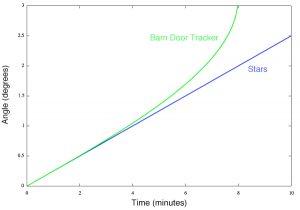A barn door tracker is a simple, homemade device that can be used to track the stars as the Earth rotates, thereby making longer exposures possible. It is a very cheap alternative to an equatorial mount.
Several types of barn door trackers exist. In this post I will just describe the basic single-arm barn door tracker as this is the one I intend to build. It can be made by attaching two pieces of wood together with a hinge. A camera is mounted on the top board, while the bottom board is fastened on something stable like a tripod. The angle between the two boards can be adjusted by turning a threaded rod or bolt.
![]()
Like the equatorial mount, the barn door tracker needs to be aligned properly with the celestial north (or south) pole. The boards are then driven apart (or together) at a constant rate following the stars. This kind of drive is called a tangent drive and the angle between the two boards is given by
The single-arm barn door tracker extends the possible exposure time from about 20 seconds to about 5 minutes for a 50mm lens. For longer exposures a tangent error becomes evident. This happens because the hinge angle does not change at a steady rate (only the length a does). In the beginning the camera can track the stars almost perfectly for several minutes, but then it gradually speeds up, “overshooting” the stars and causing their images to trail.
The most basic barn door trackers are manually operated, but an electric motor can be added to automate and improve the accuracy of the tracking process.
